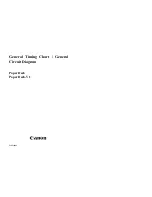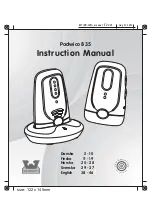
Bit Function
2
Reference overflow flag
0: Reference data has not overflowed
1: Reference data in correlation record has reached the maximum
value before overflow (this occurs when taking measurements with
biasing enabled)
1
Signal overflow flag
0: Signal data has not overflowed
1: Signal data in correlation record has reached the maximum
value before overflow (this occurs with a strong received signal
strength)
0
Busy flag
0: Device is ready for a new command
1: Device is busy taking a measurement or powering on
0x05
R/W Name
Description
Initial Value
R/W ACQUISITION_COUNT Maximum acquisition
count
0xFF
Bit Function
7:0 Maximum number of acquisitions during measurement
0x10
R/W Name
Description
Initial Value
R
FULL_DELAY_LOW Distance measurement low
byte
--
Bit Function
7:0 Distance measurement result in centimeters, low byte.
0x11
R/W Name
Description
Initial Value
R
FULL_DELAY_HIGH Distance measurement high
byte
--
Bit Function
7:0 Distance measurement result in centimeters, high byte.
0x16
R/W Name
Description
Initial
Value
R
UNIT_ID_0
Unit ID, byte 0
--
W
UNIT_ID_0_UNLOCK Write unit ID 0 for I2C
address unlock
--
Bit Function
7:0 Read byte zero (LSB) of the unit ID
Write the value in UNIT_ID_0 here as part of enabling a non-
default I2C address. See I2C_SEC_ADDR (
).
0x17
R/W Name
Description
Initial
Value
R
UNIT_ID_LOW
Unit ID, byte 1
--
W
UNIT_ID_1_UNLOCK Write unit ID 1 for I2C
address unlock
--
Bit Function
7:0 Read byte one of the unit ID
Write the value in UNIT_ID_1 here as part of enabling a non-
default I2C address. See I2C_SEC_ADDR (
).
0x18
R/W Name
Description
Initial
Value
R
UNIT_ID_2
Unit ID, byte 2
--
W
UNIT_ID_2_UNLOCK Write unit ID 2 for I2C
address unlock
--
Bit Function
7:0 Read byte two of the unit ID
Write the value in UNIT_ID_2 here as part of enabling a non-
default I2C address. See I2C_SEC_ADDR (
0x19
R/W Name
Description
Initial
Value
R
UNIT_ID_3
Unit ID, byte 3
--
W
UNIT_ID_3_UNLOCK Write unit ID 3 for I2C
address unlock
--
Bit Function
7:0 Read byte three (MSB) of the unit ID.
Write the value in UNIT_ID_3 here as part of enabling a non-
default I2C address. See I2C_SEC_ADDR (
0x1A
R/W Name
Description
Initial Value
R/W I2C_SEC_ADDR Write new I2C address after
unlock
--
Bit Function
7:0 Non-default I2C address.
Available addresses are any non-zero 7-bit values.
The five byte sequence is composed of the four byte UNIT_ID and
the one byte slave address. The UNIT_ID must be entered with the
least significant byte first.
UNIT_ID_0_UNLOCK (
), UNIT_ID_1_UNLOCK
(
), UNIT_ID_2_UNLOCK (
), and
UNIT_ID_3_UNLOCK (
) must have the correct value
for the device to respond to the non-default I2C address.
Example: UNIT_ID = 0x01020304, (LSB = 04, MSB = 01)
Example write starting at 0x16: 0x0403020155, would match on
UNIT_ID and set slave address to 0x55 (The effective 8-bit
secondary I2C address would be 0xAA write and 0xAB read)
NOTE:
You must enable ENABLE_FLASH_STORAGE before
configuring the secondary I2C address (
0x1B
R/W Name
Description
Initial Value
W
I2C_CONFIG Default address response control
0x00
Bit Function
7:0 0x00: Use the default address only (0x62).
0x01: Use the secondary I2C address only. This requires the
address to be configured using write command I2C_SEC_ADDR
(
).
0x02: Use both addresses.
0x1C
R/W Name
Description
Initial Value
R/W DETECTION_SENSITIVITY Peak detection
threshold bypass
0x00
6




























